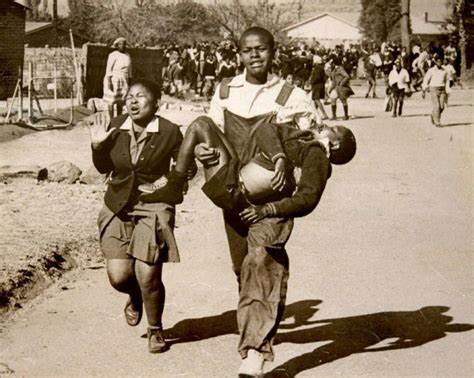Sam Nzima Photographer for freedom
记山姆·恩齐玛——为自由而摄影
By Aryn Baker
文/艾伦·贝克
IT’S NOT OFTEN THAT A picture changes the world,
一张照片改变世界的情形并不多见,
but the image of a 13-yearold boy shot by police during the June 16, 1976, student uprising in Soweto, South Africa, did.
但1976年6月16日,南非索韦托的学生起义时,一名被警察击毙的13岁男孩的照片就改变了世界。
In preserving a moment of naked horror,
照片记下了当时赤裸裸的恐怖情形,
photographer Sam Nzima, who died at age 83 on May 12, produced a potent weapon in the fight against apartheid: evidence of its brutality.
摄影师山姆·恩齐玛——这位摄影师已于5月12日去世,享年83岁——将这张照片化作了反抗前南非政策推行的种族隔离政策的有力武器:暴行的证据。

On that day, Nzima set out to cover what was supposed to be a peaceful protest.
那天,恩齐玛原本是要去拍摄一场和平抗议。
But when police opened fire,
警察对着大家开枪之际,
he captured the carnage with a singular image of a bloodied boy in the arms of a visibly distraught teenager,
恩齐玛用一张独特的照片记录了那场大屠杀,照片上,明显已经悲痛欲绝的少年抱着一个浑身是血的男孩,
his sister wailing at his side.
旁边嚎啕大哭的是他的妹妹。
Few local papers ran the photo, for fear of angering authorities,
因为担心会惹怒当局,当地报纸几乎都不愿刊登这张照片,
but the next day it was splashed on front pages from New York to Moscow.
但它次日登上了从纽约到莫斯科的各大报纸的头版。
Protesters, incensed by the death, rose up across South Africa and launched a new era of black activism.
南非各地被小男孩的死激怒的抗议者纷纷站起来,开辟了黑人行动主义的新时代。
Nzima paid a heavy price.
恩齐玛自己却付出了沉重的代价。
Forced to resign from his newspaper job, he never took another photo—
他被迫辞去了报社的工作,从那以后再也没有拍过照片——
although in 1998, after a long legal battle, he finally received the rights to his own work.
尽管经过长期的法律斗争,1998年,他最终获得了自己作品的版权。
“That picture destroyed my future in journalism,” Nzima told TIME in 2015.
“那张照片毁了我在新闻行业的前途,”恩齐玛在2015年接受《时代》周刊采访时说道。
“(But) people are free in South Africa because of it.”
“但好在南非人民因此获得了自由。”
译文由可可原创,仅供学习交流使用,未经许可请勿转载。



